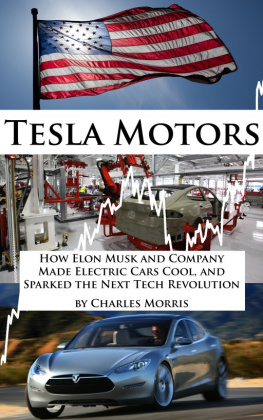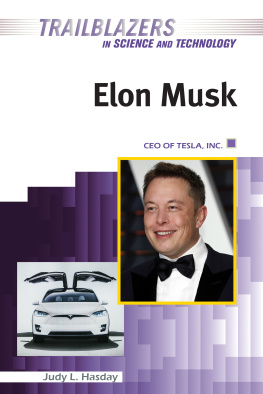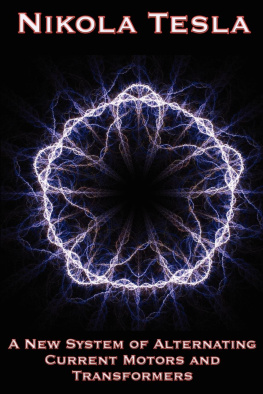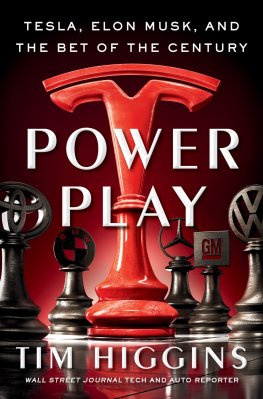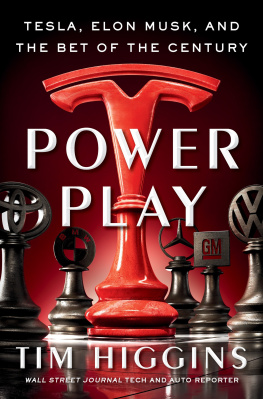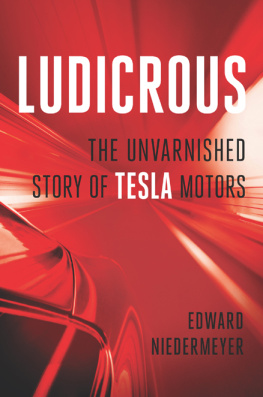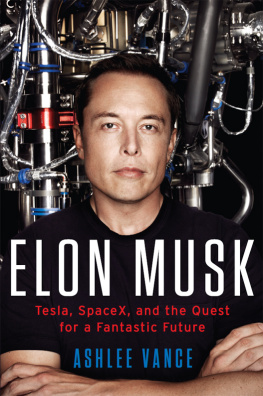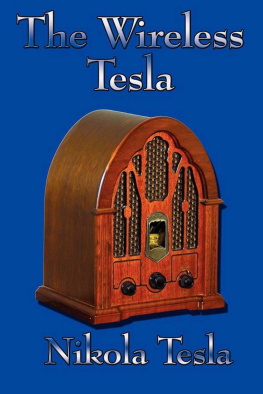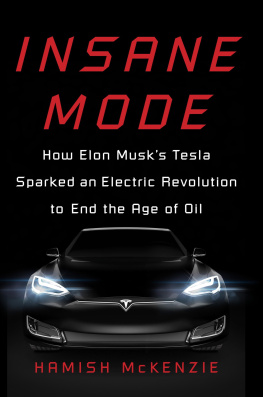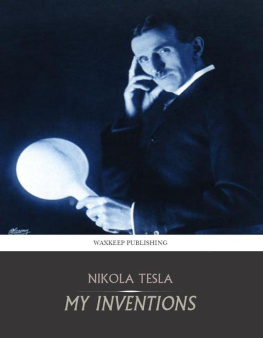Tesla Motors
How Elon Musk and Company Made Electric CarsCool, and Sparked the Next Tech Revolution
By Charles Morris
Copyright 2014 Charles Morris
All rights reserved
Smashwords edition 1.1
Table of contents
Acknowledgements
Id like to thank those who took time to tellme their parts of the Tesla story: Marc Tarpenning, Ian Wright, TomGage and Paul Carosa.
A very special thank you is due to ChristianRuoff, the publisher of Charged ( www.chargedevs.com ),without whom I would never have conceived this book. By employingme, he allowed me to gain the knowledge that went into writing it,and he also contributed a lot of specific guidance and editorialhelp during the process.
And of course, in everything I do, I thank mywife, Denise.
Photo creditsUS flag: Joshua Nathanson;Tesla auto bots: Steve Jurvetson; Model S driving: Tesla; ElonMusk/Iron Man: Steve Jurvetson; tzero: Tom Gage; Elon Musk withModel S: www.flickr.com/photos/pestoverde; Model X: CharlesMorris
1Introduction
In its eleven years of existence, TeslaMotors has made a number of remarkable achievements. It hasproduced a car that some of the industrys most influential voiceshave called the best on the market. The performance of the TeslaModel S equals that of the most venerated luxury sedans, and ithappens to use no gasoline. The company has established itself, andactually turned a profit, in an industry that, to say the least,does not welcome startups. It has changed the way the publicperceives electric vehicles and, perhaps most importantly, hasinspired several much larger automotive industry players toredouble their electrification efforts. If Tesla closed its doorstomorrow (and there are some who would rejoice to see it do so), itwould already have earned a place in the annals of both businessand technology.
Of course, Tesla has no plans to shut upshop, or even to settle into a lucrative little niche. Itslong-term goal is to grow from a low-volume manufacturer of luxuryvehicles into a much larger company that offers affordable electriccars for the masses. This is an incredibly ambitious objective, andmany obstacles lie in the way. Not the least of these iscompetition from Teslas much larger rivals, some of which havealready begun to incorporate the Silicon Valley startups bestideas into their own new vehicles, and intend to muscle their wayinto the market that Tesla has practically created. Some havespeculated that one of them will someday acquire the companyitself.
Who knows where Tesla will be in another tenyears? Not I. Crystal balls are unreliable, and they grow more soevery year, as technology motors onward and the pace oftechnological innovation accelerates. However, Tesla and itsdriving force, Elon Musk, are firmly focused on the future, somaking predictions may prove too tempting to forego as I relate thehistory of this quintessential 21st-century manufacturing firm, andconsider the questions of its lasting influence, and where it fitsinto the technological revolution that is transforming oursociety.
Two experienced entrepreneurs, MartinEberhard and Marc Tarpenning, founded Tesla Motors in 2003. ElonMusk, a charismatic immigrant to the US from South Africa, soonjoined the company as Chairman of the Board. The startups goal wasto build automobiles powered by electricity, not gasoline. It wasnot a new ideaelectric cars were common in the auto industrysearly yearsbut it was a timely one, as advances in lithium-iontechnology were just beginning to enable batteries powerful andlight enough to build cars that could rival the performance ofgas-powered models.
New technology or no, the quest to build apractical electric car was a quixotic one. Building cars isnt likebuilding web sitesit cant be done in a garage or a dorm room. Infact, the auto industry is the one that economists usually invokewhen explaining the concept of barriers to entry. Vast amounts ofcapital are required just to get into the game. Then the challengeis to design, build and market an extremely complex piece oftechnology, manage a network of suppliers, production facilitiesand distribution and service channels, navigate a maze ofregulations and requirements, and somehow do all of this betterthan the giant conglomerates that have been in the business for acentury. Even for the big boys, it may take ten years to bring anew vehicle to the market, and sales in the tens of thousands arerequired before any profit appears.
The technological obstacles were no lessformidable than the organizational ones. While all the necessarycomponents seemed to be available, it would be a challenge to putthem together into a vehicle that would perform as required at aprice that would be at all reasonable. It was also far from certainthat lithium-ion batteries, which work fine for evanescent consumerelectronics, would hold up for the 8 to 10 years required in anautomotive application.
There was also what one might call aphilosophical obstacle. Theres always a lot of skepticism aboutentrepreneurs who are motivated by altruism rather than by straightdollars and cents, as Teslas founders admittedly were. In thiscase, there would be not just skepticism, but outright hostilityfrom the automotive establishment, oil companies and certainsegments of the political sphere.
Both startups and established automakers hadtried and failed to build a viable electric vehicle (EV) manytimes. The oil shocks of the 1970s inspired a Florida company toproduce the CitiCar, but it soon gave up the ghost. In the late1990s, several of the majors brought electric models to the market,the most famous of which was General Motors EV1. The companykilled the program and crushed the cars after three years, sparkinganger and conspiracy theories among EV boosters.
However, Musk and company were determined,and they were armed with more than just awesome entrepreneurialskills and deep pockets. They had a brilliant idea: instead ofbuilding a sensible, money-saving car, they would build a sexy,sporty little racer.
It worked. Ten years later, the Roadster hasbeen honorably retired, and the companys second car, Model S, isselling well and garnering one rave review after another. Thecompany has declared a profit and is going full speed ahead withits plans for another model, and another. The millions who havejust tuned in to the story may wonder, whats the big deal? And whydidnt the major automakers think of this a long time ago?
As we study the history of Tesla, well seethat it was a hard road, with several near-fatal incidents alongthe way. Well also learn that, while the company has achieved manyimpressive feats in the realms of technology and businessdevelopment, the real reason for its success is quite simple: itconceived and produced revolutionary products.
The undisputed quality of those products owesmuch to a long series of wise technological decisions along theway. Some of these seemed daring (or foolhardy) at the time theywere made, but later proved to be selling points against Teslascompetitors.
Teslas decision to use standard laptop-stylebatteries to power its cars sounds like a hack that might have beenthought up in a college dorm room. However, it means that Teslawill never have problems securing a supply of batteries. Most otherEVs use highly-specialized, large-format battery cells that couldbe hard to obtain if a battery maker goes out of business (a notinfrequent occurrence).
Teslas decision to design Model S from theground up as an electric vehicle, rather than adapting an existinggas-powered model as most other companies have done (and as Tesladid with the Roadster), has given it several advantages over othercurrent EVs. The battery pack in Model S is flat, and sits at thebottom of the chassis, which gives the car a low center of gravityand greatly improves handling and safety. It also frees up a lot ofspace for passengers and cargo, which is a sore point with mostother EVs. That bulky battery has to go somewhere, and most EVmakers have resorted to awkward compromises, usually sacrificingtrunk space, as many auto reviewers have noted. Model S, on theother hand, has

